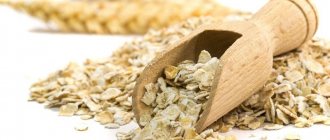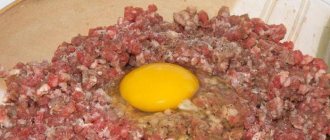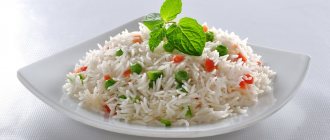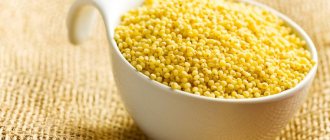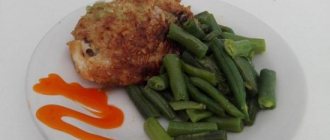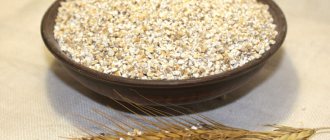Calorie content of pasta and cereals is always indicated in terms of dry product. The calorie content of porridge is usually no more than 130 kcal per 100 grams. This is a filling and low-calorie product. Cutlets: calculate the calorie content of the minced meat and all ingredients and add 20% of the oil poured into the frying pan. Divide this calorie content by the number of cutlets (in pieces). It must be remembered that usually the weight of cooked products is less than the weight of raw products due to frying, boiling, and accordingly the calorie content per 100g of the finished product increases.
How to count calories?
From this point of view, the increased caloric content of boiled cereals will be more of a plus than a minus, because this is nothing more than the necessary energy that is fully utilized by the body.
And when preparing complex dishes, it also takes no more than 5 minutes to weigh the ingredients, write down the weight, then weigh it and enter it into the counter. It's not that difficult to count calories. I’ve been trying to gain weight, so I’ve been counting calories in foods for about a year. There are many different programs that you can use.
Calorie content of porridges (cereals): with water, boiled, with milk (table)
Probably, it was then, even in early childhood, that many people develop an inexplicable hatred of cereals and a reluctance to include them in their daily diet. However, every person must eat porridge!
The calorie content of dry cereals ranges from 300 to 350 kilocalories per 100 grams. Such a high energy value has made cereals indispensable throughout all centuries of human history. The source of calories in cereals are complex carbohydrates. Whole grains that are crumbly when cooked will be digested the slowest. Cereal products should be consumed in moderation. Semolina porridge with water contains 80 kilocalories per 100 grams. Oatmeal contains the largest amount of fat (about 7.5% by weight). Nuts, honey, and many dried fruits contain a lot of calories (more than 400 kilocalories per 100 grams). The calorie content of cereals without additives is relatively low.
Why is there such a difference in the caloric content of cereals and porridge on water, and how to calculate the caloric content of porridge? As you know, water has no calories. No, you didn’t hear it that way, that’s exactly it. Semolina porridge is quite allergenic due to the vegetable protein gluten it contains. Millet porridge helps remove excess salts from the body; it is a good fat burner. Rice porridge, containing vegetable proteins and starch, is easily absorbed by the body and is the lowest in calories. Therefore, looking at the table of calorie content of porridges, it is also necessary to take into account their benefits for the body, and, based on this ratio, think about whether porridge is needed in the daily diet. As for fats, there is very little of them in buckwheat, only 3.3 grams per serving.
The abundance of cereals presented on the shelves of our stores is mainly whole or crushed grains of various cereals, legumes, as well as rice and buckwheat. Cereals are an indispensable dietary product, and depending on the method of preparation, they can have different effects on the human body. Thus, porridges prepared in liquid form have a gentle effect, while crumbly ones help remove toxins from the intestines. Most domestic nutritionists consider buckwheat to be the healthiest, given its mineral composition. Although the remaining cereals are inferior to buckwheat and oatmeal in a number of indicators, each of them has certain advantages.
Calorie content of buckwheat porridge on water
Buckwheat porridge has an unusually rich composition. Especially high in unsaturated fatty acids and multivitamins. This helps speed up metabolism and lower levels of “bad” cholesterol, which contributes to successful weight loss.
Note! Buckwheat is rich in protein, so it can be a substitute for animal protein for those who decide to give up meat.
Buckwheat is most often boiled in water, only then adding milk if desired. However, buckwheat is tasty on its own and rarely needs any additions. This dish is considered dietary.
Thanks to its composition, buckwheat is actively used for weight loss, even without taking into account how many calories are in porridge with water. The buckwheat diet in its pure form is tough, often inconvenient due to its monotony, but helps to quickly lose weight. Weight loss during the diet is 3-5 kg. If you diversify your diet by adding fruits, vegetables and dairy products in addition to buckwheat porridge, your weight loss will slow down somewhat. But in the near future, such a menu will help you switch to a healthier diet or quickly recover after heavy feasts.
However, not everyone knows how many calories are in buckwheat porridge with water. Like other cereals, the calorie content of buckwheat is quite high - about 355 kcal/100 g. To reduce the calorie content, it is recommended to cook the cereal in more water. This simple measure allows you to “remove” approximately 150 kcal. Salt may be added during cooking. If you add a little of it, the taste of the porridge will be much better, and the calorie content will increase slightly. It is worth noting that a serving of buckwheat porridge is slightly smaller than a serving of oatmeal - approximately 90 g, so the calorie content is generally lower.
To reduce calorie content, it is recommended to cook buckwheat in more water
Calorie composition
Cereals are high in calories, and that's true. When cooked, cereals significantly lose their calorie content.
The entire volume of cooked rice porridge will have a calorie content of 990 kcal: except for water and salt, which, as we already know, have no calories, we did not add anything else.4. Using a similar scheme, we calculate the calorie content of boiled pasta, beans, and lentils. 1. The total weight of products needed to prepare pumpkin puree soup is 2675 g. 2. The total calorie content of the products is 1630.5 kcal.3. The weight of the finished dish is 2562 g and contains the same 1630.5 kcal (I remind you that water evaporates, not calories).5.
Cereals contain slow carbohydrates. Slow carbohydrates contained in cereals are not stored in the body as fat, but are completely absorbed, maintaining a feeling of satiety and energy balance. This is why cereals are a valuable dietary product.
If the first course with meat is cooked, then its calorie content is also distributed over the finished dish and when weighed, we take the total calorie content. To the resulting calorie content of the product, 20% (50%) of the calorie content of the oil used to cook is added. The resulting calorie content is multiplied by 0.2. Next, the weight of the finished broth is determined, and the resulting calorie content is distributed over the entire weight of the broth. To determine the calorie content, you need to weigh the fruit in its raw form and use the resulting weight to determine the calorie content of the product.
1. To prepare fried chicken fillet we need 650 g of products.2. The calorie content of sour cream sauce will be equal to the calorie content of your sour cream: greens and garlic are very low-calorie foods.4. The weight of chicken fillet after cooking is about 400 g and contains the same 768 kcal.5.
After cooking, the weight of boiled meat is about 700 g: boiled meat has decreased in volume and weight.4. You won’t be able to drink enough broth in a day to catastrophically go over your calorie intake.
If you open any calorie counter, you will see that with raw ingredients like oatmeal, chicken, cabbage, etc. Plus, the calorie content of vegetables and their fiber content can vary greatly. The more liquid you add, the more porridge you get, while the calorie content of the cereal remains the same. Calculating the dry weight of grains does not mean that you need to cook each portion separately.
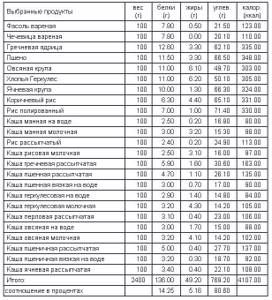
Before calculating the calorie content of porridge, cook the required amount. Remember that the calorie content of the porridge will depend on what you cook it with. Before calculating the calorie content of porridge, read the packet of cereal to see how many calories it contains. Calculating the calorie content of porridge is not difficult, you just need to understand the calculation method.
In order for porridge to benefit the body and not add extra pounds, it must be prepared and consumed correctly.
Cereals rightfully occupy one of the central places in the niche of every person’s daily diet. They have always been popular both among ordinary people and among celebrities and “great people”. In every kitchen in the world you can find at least a few dishes that can be prepared with cereals, and if we talk about traditional Russian cuisine, here they can be found in every third dish.
We all know that cereals and porridges prepared from them are irreplaceable and beneficial for our body, which is why the question of the nutritional value and calorie content of cereals interests almost everyone. Those who adhere to the principles of proper nutrition and watch their figure are especially interested in the calorie content of ready-made cereals, because it is known that cereals and cereals are a valuable source of slow carbohydrates, so they give us vigor and the necessary energy.
However, some believe that the increased calorie content of cereals does not allow them to be used in dietary nutrition. Nutritionists also constantly argue about this, but most of them prefer diets with their participation, so they strongly recommend leaving at least a small amount of cereals in the diet of those losing weight.
Brief summary of recommendations
In order to successfully and correctly count calories in borscht, soups, casseroles and other dishes, you will need the following: kitchen scales, calorie tables, calculator, notepad and pen.
It is best to choose electronic scales This way you will know the exact weight. It's easy to test the scale before purchasing: take a small object (or several objects) whose weight you know and place it on the scale several times. Reboot the scale and test again. If the number does not change, the scales are not lying. Many manufacturers allow an error of +/- 5 grams. Tables of weights and measures for determining the weight of food are not helpful here: after cooking, you will need to weigh the dish in order to calculate its total calorie content, and then your one serving.

A collection of calorie tables can be found in any bookstore, and you will always have it at hand. The calorie content of the product is also indicated on the packaging. The numbers may vary slightly in different tables. Choose one table for yourself and use only that one.
all kitchen utensils in advance, so that later you can easily subtract the weight of the dishes or plates.
When preparing dishes, it is important to remember: the calorie content of water and salt is 0 (zero) kcal. But water adds weight and thereby changes the overall calorie content of the dish.
The more water you add, the more weight and the fewer calories per 100 grams
A dish that you have counted once does not need to be counted unless its composition changes. Just write down the quantities of ingredients you need in your notebook.
And most importantly, the formula for calculating the calorie content in 100 grams of a finished dish:
A grams = B kcal
100 grams = X kcal
How to understand the symbols in this formula?
• A (grams) – total weight of the finished dish in grams;
• B (kcal) – total calorie content of food in the finished dish.
How to use this formula?
We multiply the two numbers diagonally by each other and divide by the number that is diagonally with X:
B × 100: A = the number of calories in 100 g of the dish you prepared.
Is the formula not very clear? Let's look at detailed examples of how to apply it in practice.
Why are cereals so beneficial?
Many people have known the beneficial properties of cereals since childhood, especially if you remember how grandmothers said that you need to eat cereals in order to grow big and strong, but their positive influence does not end there. In addition to the high nutritional value and calorie content of cereals, the main explanation for this is considered to be the presence of slowly digestible carbohydrates, which, when broken down under the action of enzymes, release a large amount of energy necessary for the functioning of the body.
The main advantage of slow carbohydrates (as opposed to fast ones) is the absence of an abrupt release of insulin into the blood, so we feel full longer and also put ourselves less at risk of diabetes.
Dishes containing cereals are recommended not only for children and adolescents, but also for older people and those who are subject to increased physical activity. From this point of view, the increased caloric content of boiled cereals will be more of a plus than a minus, because this is nothing more than the necessary energy that is fully utilized by the body. Also, the benefits of cereals are explained by their different and rich vitamin and mineral composition, so each type is indispensable for normal human functioning.
Dry cereal calorie table
In order to know the calorie content of cereals of one type or another, it is not at all necessary to memorize difficult-to-understand numbers every time. To do this, it is enough to always have on hand a table of calorie content of cereals, which sets out this information. Let us give an example of a table of caloric content of dry cereals, which indicates the number of calories per 100 grams of this product.
As can be seen from the table of caloric content of cereals, unpolished rice contains the most calories, and barley contains the least. But basically, almost all of them have similar caloric content of cereals, which cannot be called low. Along with the calorie content of dry cereals, the calorie content of finished cereals is also important.
Calorie content of boiled cereals. What does it depend on?
It is known that the calorie content of raw and cooked foods is usually different. The same can be said about cereals. During the cooking process, the cereals boil and swell, they become heavier and change their consistency, which is why the calorie content of the finished cereals also changes. For clarity, let’s look at the calorie content of boiled cereals depending on their type.
These porridges are the most popular, especially buckwheat, which has the highest calorie content. What else does the calorie content of cooked cereals depend on?
As we have already found out, the calorie content of cereals does not determine the calorie content of the future porridge prepared from it. In addition to the peculiarities of preparing cereals, their calorie content in finished form is also influenced by additional ingredients that can be used in the dish. For example, if you cook semolina with milk, the calorie content of such porridge will be slightly higher and will be 98 kcal per 100 g, in contrast to the calorie content of semolina with water. If you add another piece of butter and a spoonful of sugar to the finished porridge, its calorie content will increase significantly and amount to about 300 kcal per 100 g.
Therefore, we can safely say that the calorie content of cooked cereals directly depends on the additional ingredients in the dish. In addition, cereals often act as an independent side dish for meat, fish and vegetable additives, so the total calorie content of the finished dish will depend on how high-calorie they are.
If you are watching your figure and are afraid of gaining weight, you do not have to completely exclude cereals and dishes containing them from your diet. You just need to control the amount of additives you can use when preparing them, as well as the size of the portion you eat. It is best to eat porridge in the morning and at lunchtime. This way they help you feel a surge of strength and energy, and are also better absorbed by the body.
Nutritionists also advise everyone who is losing weight to cook and eat only those cereals that have been cooked in water without adding sugar, salt and other additives, because they do not contain extra calories. In this case, the high calorie content of cereals will not interfere with weight loss, and with the right approach will even promote it. This is confirmed by numerous diets for weight loss based on cereals, which have been successfully tried by millions of women.
3.8 out of 5 (11 Votes)
Cereals and grains, which are integral components of any porridge, are quite healthy and at the same time satisfying products, which contain a huge amount of various nutrients that bring only benefits to our body. Today we will discuss in detail the calorie content of cereals, find out what types of cereals exist, and also discuss a large amount of other useful information. Let's start!
Not every resident of the country knows that cereals contain a huge amount of fiber. Yes, it is not absorbed by the human body, but it still has one very useful property: fiber absorbs a wide variety of waste, toxins, sugar and excess cholesterol, and then removes all this from the body. It is also worth noting that fiber is a very good remedy for combating constipation, so if you have problems in this area, you should start eating right and eating as many cereals as possible.
Additionally, it is worth noting that any porridge for children, as well as for adults, contains a huge amount of vitamins. For example, the most common vitamin in any group is vitamin B. This type of vitamin is of great importance for any organism. B vitamins take part in metabolic processes, they improve the functioning of almost all organs of the human body, improve the condition of hair, and normalize digestion. It should be noted that in the same way, B vitamins have a positive effect on the condition of nails, skin, as well as on the health of the heart and blood vessels. They slow down the aging of the body and have another very positive property - they prevent the formation of cancer cells.
In the same way, the following should be highlighted from the positive properties of cereals:
- normalization of sleep;
- improved mood;
- increasing stress resistance;
- increased performance;
- improving attentiveness and memory.
What is calorie content
Calorie content is the amount of energy that the body receives from a certain food product. Accordingly, the calorie content of a finished dish is the sum of the calorie content of all the products included in the dish. This explanation may seem like a completely banal thing to you, but it is precisely because of a lack of understanding of this basic information that, as a rule, errors in calculations occur.
Since we are talking about energy, calorie content is also called the energy value of the product. This indicator is measured in two units: calories (k) and joules (J). Mathematically, 1 k = 4.2 J. But in fact, both a calorie and a joule are a very small amount of energy. Therefore, measurements are usually made in kilocalories (kcal) and kilojoules (KJ), but in everyday speech, as a rule, they simply do not say “kilo”.
Recently, on product labels, more and more often you can see double information about composition and calorie content: in calories and in joules. However, in the CIS countries it is usually calculated in calories, so I will also rely on this unit of measurement.
Calorie content of cereals
Any cereal contains proteins, amino acids and carbohydrates. All these substances one way or another take part in the construction and production processes of any organism. In addition, it should be noted that any cereal also contains fatty acids, which have positive properties and have a good effect on the body’s metabolism.
However, the main source of calories in porridges made with water or milk is still slow carbohydrates. It is thanks to these substances that cereals saturate the body of any person with energy. In addition, after eating porridge, the feeling of hunger subsides for at least two to three hours.
It is important to note that any cereal contains microelements such as calcium, which is necessary for bone growth, potassium, which strengthens muscles (including the heart), magnesium, which significantly improves the functioning of the central nervous system, as well as iron, which has a positive effect on blood composition, and other important vitamins and minerals.
One of the most popular types of cereal in the modern world is buckwheat. Today, experts distinguish between crumbly and viscous buckwheat. Their caloric content differs, and the caloric content of one is almost 2 times higher than the caloric content of the other.
So, are you interested in types of healthy cereals? Then be sure to pay attention to buckwheat porridge! The calorie content of buckwheat is approximately 163 kilocalories per 100 g of finished product. At the same time, viscous buckwheat has a lower calorie content - only 90 calories per 100 g.
At the same time, it is definitely worth noting milk, which is approximately 118 calories per 100 g. As you can see, cereals are really tasty and at the same time low-calorie foods that can be eaten by both adults and children. Buckwheat with milk is an excellent porridge for children, which will definitely charge your child with a lot of energy before school or kindergarten.
This type of cereal is one of the least caloric. 100 grams of oatmeal contains only 73 kilocalories. The calorie content of oatmeal is indeed very low, so along with this versatile product, you can eat a variety of higher-calorie foods. Oatmeal goes well with fruit!
Of course, with a banana or some other ingredient it will be slightly higher, but the taste of this masterpiece of modern cooking will also be at its best.
Rice porrige
Rice is a luxurious product that today we are accustomed to seeing as the main ingredient for sushi and rolls. By the way, these Japanese dishes are also low in calories, so pay attention to them. The calorie content of rice porridge depends on the type of rice!
100 g of viscous rice porridge contains only 97 kilocalories. At the same time, fluffy rice contains 113 kilocalories per 100 g of finished product. As you can see, the calorie content of rice porridge is also quite low, so no one forbids you to combine this healthy cereal with other tasty dishes, such as meat. However, do not forget that the meat must be cooked correctly!
How many calories are in broth and compote?
When cooking, part of the calories is transferred from the food to the broth: from fish - 15%, from meat - 20%, fruit - 30%, dumplings, manti and khinkali - 20%. These numbers may fluctuate: it all depends on the cooking time of the products.
Let's calculate the calorie content of salmon fish broth. Take a salmon steak weighing 300 g and 1 liter of water. Calorie content of salmon in 100 g = 142 kcal, in 300 g of this fish = 426 kcal (142 × 3).
426 kcal – 15% = 63.9 kcal (rounded to 64 kcal).
1 liter of salmon broth contains 64 kcal . 100 ml of broth contains only 6.4 kcal!
Millet porridge
Millet porridge or millet is also a fairly popular dish in Russia and other countries of the world. The calorie content of crumbly millet porridge is only 135 kilocalories per 100 g of finished product. Yes, this figure is higher than that of buckwheat, semolina, which reach 80 kilocalories per 100 g, and others, but it cannot be said that millet porridge is harmful.
In addition, it is important to note that the calorie content of millet porridge with milk is slightly lower. In this case, it is only 121 kilocalories per 100 g of finished dish.
By the way, you can also combine this dish with useful additional ingredients. Here you can add nuts, dried apricots, dried fruits, berries, jam and other healthy and at the same time tasty ingredients.
Thus, the calorie content of millet porridge with milk is lower than the calorie content of the same dish, but cooked with water. Interesting, isn't it?
How to correctly calculate the calorie content and nutritional value of foods
In this case, everything is simple. The packaging of each product always contains information about its energy value and nutrient content. Therefore, if you want to find out, for example, what the calorie content and BJU of a pack of cottage cheese are, then just look at the packaging. But do not forget that the data there is given per 100 g of product. Accordingly, if you ate a pack of 250 g, then the data needs to be multiplied by 2.5.
What if the product does not have packaging?


